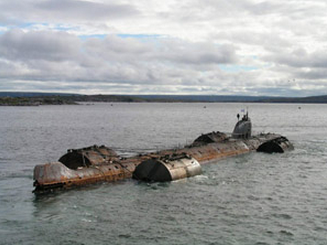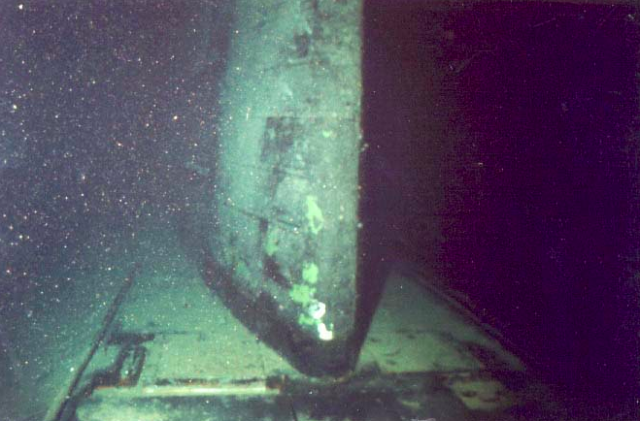
The system built to manage Russia’s nuclear legacy is crumbling, our new report shows
Our op-ed originally appeared in The Moscow Times. For more than three decades, Russia has been burdened with the remains of the Soviet ...
News

Publish date: May 26, 2014
Written by: Anna Kireeva
News
MURMANSK – It is of critical importance that two sunken derelict Russian nuclear submarines, one of which was scuttled as radioactive trash and the other of which sank in rough weather on its way to decommissioning, be raised from the floor of the Kara Sea, scholars from Moscow’s Kurchatov Institute said Friday.
The two subs in question – the K-159 and the K-27 – lay on the ocean floor, the first at the entrance to Kola Bay and the second in the shallows surrounding the Novaya Zemlya Archipelago, a former nuclear bomb testing range during Soviet times, as well as something of a dumping ground for Cold War legacy nuclear waste.
Both have also been the subject of long-time promises by Russian officials that they will indeed be raised.
According to Alexei Kazennov, a researcher with Moscow’s respected Kurchatov institute, the K-159, which sank in August 2003 under tow to decommissioning at the Nerpa shipyard – in more than 200 meters of water, taking with it 800 kilograms of highly enriched uranium fuel and claiming the lives all nine sailors aboard – is currently emitting one and a half times as much radioactivity as dozens of other radiological hazards dumped at sea over time by the Soviet and Russian navies.

The K-27 submarine, was scuttled in 50 meters of water in Stepovogo Bay of the Novaya Zemlya Archipelago in the Kara Sea in 1981 after a serious reactor accident that killed nine. Its reactors contain 90 kilograms of uranium-235.
Kazennov said Russia was studying and observing its sunken radiological dangers while the United States was paying no attention to its own submarines sunken in the Atlantic, though he citied no concrete evidence for this nationalist salvo. It is also worth note that the sunken American subs – two of eight sunken nuclear subs in the world – sank as a result of accidents, and were not, as was the K-27, sunken on purpose.
“No one knows about the American vessels, and their condition must be far worse than our sunken submarines because they were not prepared for sinking, and therefore sunk with damage, and there are doubtless many problems there,” he told the Public Council on Safe Use of Nuclear Energy seminar in Murmansk last week.
According to information obtained by Bellona for its 1996 report “The Northern Fleet – Possible Sources of Radioactive Contamination,” two US submarines currently lay at the bottom of the Atlantic: the Thresher, which sank in 1963 during dive tests 350 kilometers off Cape Cod, Massachusetts, and the Scorpion, which imploded when reaching crush depth 740 kilometers Southwest of the Azores. All crewmembers were killed in both cases.
No information has been made public regarding possible radiological hazards posed by these vessels.
The fact that Russia – at least in Kazennov’s opinion – is closely monitoring the conditions of its sunken vessels doesn’t mean it’s in any technological position to raise them. The biggest problem regarding Russia’s downed vessels is that the chain of their custody and who is responsible for them is sketchy – save for the K-159, which is the clear purview of Russian Ministry of Defense.
“The necessity of raising the K-27 and the K-159 has long been under discussion,” said Alexander Nikitin, chairman of the Environment and Right Center (ERC) Bellona in St. Petersburg. “Three years ago, they were established as priorities. Therefor it’s time to discuss the practical aspects and make some steps in this direction. The time for committee meetings is over.”
The K-159
According to Kazennov, the K-159 poses the biggest radiological contamination potential. In 2012, it was established that the spent nuclear fuel in its reactors measured some 5319.7 terebequerel (143.8 kilocurie), which exceeds the activity of Russia’s other sunken radiological objects. The K-159 lacked an extra protective barrier between the spent nuclear fuel storage and the rest of he submarine, which increases the risk of possible radioactive leakage. Because the ship sunk in an accident, there were no special precautions taken to seal its cargo of spent fuel.

It is worth bearing in mind that the K-159 sunk while under tow across a major ship-trafficking waterway as well as one populated by fisheries. The most recent examinations of the vessel, from 2007, showed that it posed no special radioactive hazards, and that the integrity of the reactor compartment was intact.
“Things could get very complicated if the first compartment looses integrity, but we don’t know its current condition,” said Kazennov. “Over the summer a joint Russian-Norwegian expedition to the sunken vessel will take place – we will try to get new data.”
He added that it is essential to raise the vessel regardless of the circumstances, as a possible rupture in the reactor compartment could greatly complicate matters if it is not raised.
Other radioactive litter in the Kara Sea
Large-scale dumping of radioactive waste and nuclear fuel was at its height between 1965 and 1972. Some 17,000 tons of solid radioactive waste are estimated to have been purposely sunk in its waters, in addition to the K-27, and the 907 nuclear submarine, which has two reactors on board. Other solid radioactive waste in the region includes biological shielding assemblies from the Lenin nuclear icebreaker, whose location has not yet been determined. Another piece of unaccounted-for nuclear trash under the sea is the port-side reactor of the 421 nuclear submarine.
According to the Kurchatov Institute, the biological shields are the most radioactive of waste items sunk in the Kara Sea, second only to spent nuclear fuel. The activity of a caisson with such a biological screen in 2012 measured 1196.7 terebequerel, or 32.4 kilocurie, which is some 30 percent of the entire activity of radioactive waste submerged in the Kara Sea.
Despite outer damage observed on the surface of the caisson, the integrity of the remaining barriers has remained intact, and there have as yet been no releases of technogenic radionuclides into the environment, said scientists from the Kurchatov Institute. But in circumstances of corrosion of the barriers or damage to the integrity of the caisson, the radiation situation in the Kara Sea could deteriorate rapidly.
Of special interest is the Komsomolets nuclear submarine, which sunk during an accident in 1989 and whose reactors were not prepared for submersion. The Komsomolets is the only vessel from which the escape of radionuclides into the undersea environmental has been established as a result of loss of integrity of the No 1 reactor chamber.

However, the most recent investigation of the vessel, dating back to 2007, established that since 1994, the concentration of radionuclides escaping the vessel has been on a steady decrease of up to 30 times the initial measurements.
“This vessel is a real study specimen in the research of the behavior of radionuclides in seawater,” said Kazennov.
He added that studies of the K-27 occur every year and so far no escaping radionuclides have been discovered, which he says means the defensive barriers of the vessels have eroded over the past year. He said that in this circumstance it was now possible to start devising means of raising it.
“It’s best to bring it up and dismantle it, all the more so because the Gremikha [radioactive storage base] now has all the necessary technology to do so,” Kazennov said. “If we don’t do it now, then there won’t be anywhere to do it in the future.”
Risks to oil and gas activities
Kazennov added that a detailed inventory of sunken radiological hazards in the Arctic is necessary, after which a complex radiological engineering study can be completed. This will facilitate the creation of a database on the conditions of the sunken radioactive junk, leading to a future master plan for handling it.
“It’s necessary to take decisions, political decisions about what to do with these items,” Kazennov said. “In my opinion, they should be raised especially as they constitute a serious difficulty to gas and oil projects in the arctic.”
He said that the radioactive litter in the Kara Sea could interfere with drilling works for oil and gas companies, on which Moscow seems to be placing the majority of its economic bets. Containers of solid radioactive waste are strewn across the floor of the Kara Sea, and it would be easy to stumble upon one during oil and gas drilling.
“Our specialists have already been present for test drilling in the Kara Sea, and carried out measurements before boring each test well,” he said.
This report was translated by Charles Digges (charles@bellona.no)

Our op-ed originally appeared in The Moscow Times. For more than three decades, Russia has been burdened with the remains of the Soviet ...

The United Nation’s COP30 global climate negotiations in Belém, Brazil ended this weekend with a watered-down resolution that failed to halt deforest...

For more than a week now — beginning September 23 — the Zaporizhzhia Nuclear Power Plant (ZNPP) has remained disconnected from Ukraine’s national pow...

Bellona has taken part in preparing the The World Nuclear Industry Status Report 2025 and will participate in the report’s global launch in Rome on September 22nd.